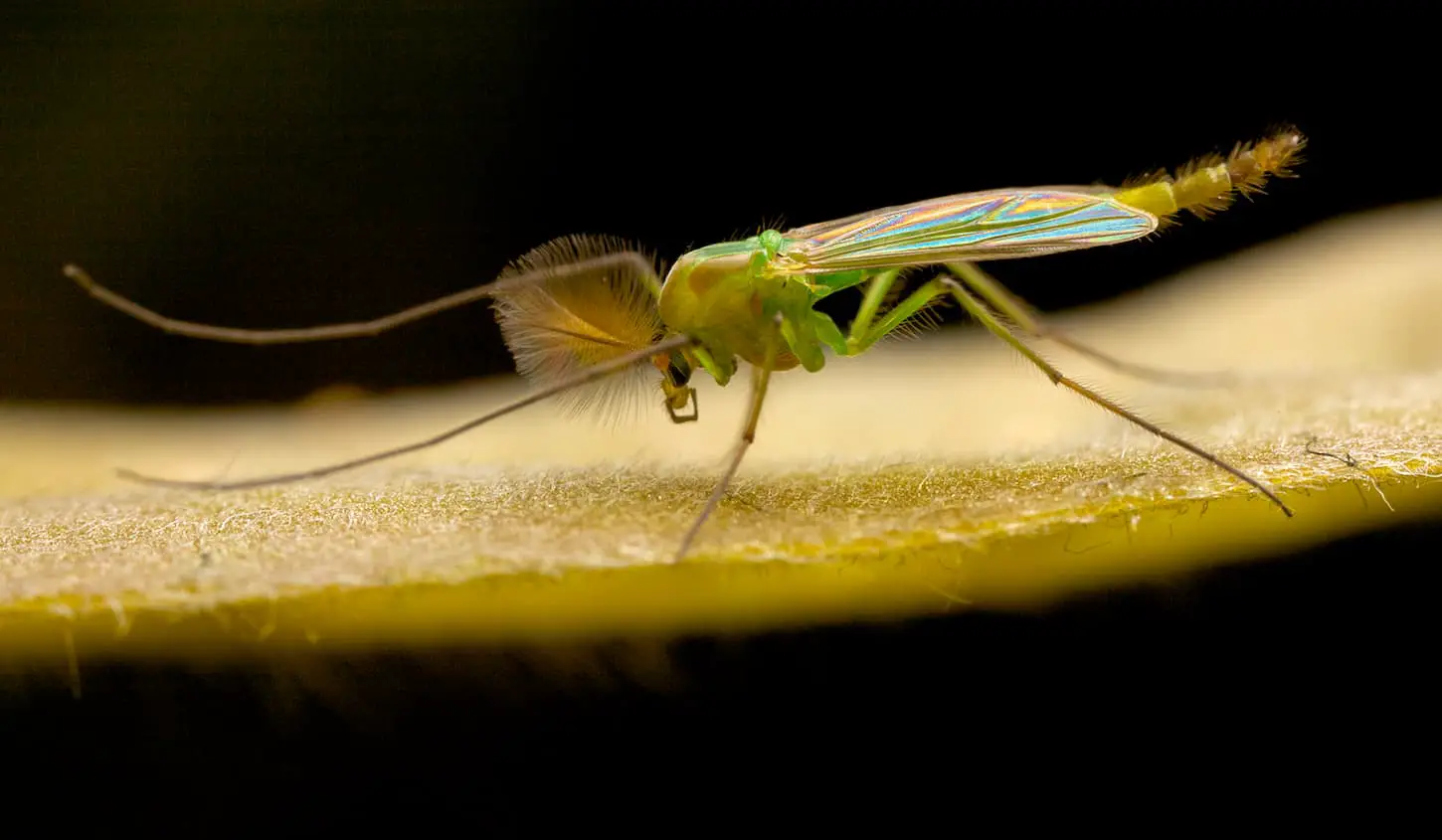Midges are, as many gardeners were unfortunate enough to find, small flies that look like mosquitoes and are often found in arid areas. They’re sometimes called no-see-ums, biting gnats, punkies, or moose flies. Some species, such as the highland midge, are known to bite people and pets, which is why many people are looking to learn how to get rid of these biting gnats in gardens.
Keep the garden free from midges by minimizing standing water, decomposing vegetation, and manure. These three things are attractive to midges because they need them to breed. Keeping the grass short will improve aeration, which can blow them away.
There is, however, more to this question than it might seem. So, read on to learn how to get rid of midges and prevent them from reappearing – and a bit about their habits!

What Are Midges?
Midges are a type of insect or two-winged fly that commonly looks very similar to a mosquito, although it has a very different mouth. Midges are sometimes also called punkies, no-see-ums, moose flies, or biting gnats. Midges bite and require a blood meal in the egg-laying part of the reproduction cycle.
They aren’t mosquitoes, but they’re just as bad.
What Is the Best Way to Get Rid of Midges?
The best way to get rid of midges is to create an area that discourages midges from living and breeding there. Midges love both grasses and gardens as they are their ideal breeding grounds. They lay their eggs in mud, decaying vegetation, and manure, as they need moisture to keep them from drying.
How to get rid of midges in gardens
It can be difficult to control midges in the garden because we need to water our plants, and midges are attracted to moisture. However, keeping the garden free from stagnant water is a great step in the right direction.
Another thing that we can do is keep our gardens free from decomposing vegetation. Like all animals, midges only infest areas that can support their survival – cutting out water and decomposing vegetation makes a garden inhospitable.
There is bad news too. If our homes are close to a permanent water source, such as a stream, a river, or a lake, chances are we won’t be able to do anything about the midges.
These insects often spread within a two-mile radius of their breeding grounds; unfortunately, there is no way to dry out those water sources outside our control (or outside of our fence).
Experts recommend that livestock and house animals be kept at least 2 miles away from biting midge breeding areas (source).
How to get rid of midges in grassy areas
Unfortunately, spraying insecticide isn’t that effective against midges. We would have to spray large areas daily to keep midges at bay for a long time!
This isn’t an option with the garden because we’ll kill or deter all beneficial insects we need for pollination. It would normally be an option for grass, but it’s ineffective.
The only time insecticides for midges are recommended is during extremely intense infestation periods.
The only real solution for grass infestations is removing midge attractants from the environment – this includes water sources and decaying vegetation, which we mentioned earlier.
White lights are also proven to attract adult midges (source), and while electrocution traps can kill midges, they aren’t likely to kill enough midges for us to spot a difference.
We understand that this isn’t the news people want to hear, but the truth is our most powerful asset in midge control is keeping our homes inhospitable to them. Once again, remember that the infestation might not even be in the home but at a water source less than two miles away.
What Keeps Midges Away Outside?
Aside from making the home inhospitable, midges can be kept away by the introduction of natural predators. This includes frogs, small birds, and fish (if there is a pond).
As we learned, insecticides are only effective for a short while. When they’re applied, they have to come in physical contact with the insects to kill them. Since insecticides evaporate quickly, they’re mostly inefficient.
The most effective midge-control strategies include minimizing humidity, maintaining vegetation, and increasing air movement (source). We can increase air movement by keeping the lawn mowed.
Another strategy we can try is using citronella candles, although they’re only effective in partly closed areas, such as the patio or the terrace.
Unfortunately, if there’s a midge infestation of a water source (be it in the yard or just near the home), there’s very little we can do about it. The University of Florida says that keeping midges away is borderline impossible, and insecticides are “mediocre at best.”
This is a community issue – not our personal issue, which is why we must bring it to the attention of the proper authorities. The most effective way of controlling midges is by impounding swamps and marshes, which is the local government’s job – not a job for us personally.
For example, we live less than 2 blocks away from protected wetlands. There is nothing we can do about the wetlands, and we don’t want to lose them. They’re a crucial part of the natural environment here. They’re vital to migratory birds, local animals, and endangered species. That doesn’t mean we like mosquitoes or midges, though.
However, our state also has an aggressive mosquito abatement program to keep mosquitoes under control. It’s a whole other topic for another day. Even so, it’s nice to know that the local government is balancing everything (or at least trying to).
What Smells Keep Midges Away?
Indoors, citronella and commercial insect repellents will help deter midges. Outdoors, environmental control is the best way to deter midges long-term, though citronella or insect repellents may help control midges in parts of the yard (weather permitting).
Mothballs are also effective against insects (although it’s imperative that we don’t just put them anywhere as they can be harmful to people), especially indoors.
However, none of these smells will keep midges at bay outside. Long-term outside control has nothing to do with smells and everything to do with maintaining an inhospitable environment.
When Do Midges Go Away on Their Own?
Believe it or not, midges are less active during the night because of the temperatures and winds, not because of the darkness. They don’t care for too much light or dark.
Finally, a question that we can answer with some good news! Midges usually go away after sunset – they are most active before dawn and dusk. Midges prefer the weather not to be windy and are known to hunker down if the wind speeds go above 6 miles per hour and/or when the humidity drops below 60% (source).
Depending on the region, midges can be active throughout the entire year (although this is more common in warmer regions). In temperate climates, they remain active until the sudden temperature drop – usually in October and November.
- In Scotland, for example, they usually go away in October and return from dormancy in April.
- Here in Utah, midges are super common in the Southeastern part of the state. They’re typically most active in late spring and early summer.
What Attracts Midges?
Unfortunately, midges are attracted to humans among other animals. The females need a blood meal to fertilize the eggs; the only way they can get that is by biting into a live animal.
Because of this, they’re often attracted to man-made habitats.
What plants can you have to distract midges?
Plants that can distract or discourage midges include catnip, lavender, mint, rosemary, eucalyptus (although it could be difficult to grow outside, depending on location), and thyme.
First, know that midges will ignore foul smells if they want to invade the yard. If you’re having a cookout in the yard, it’s essentially a cookout for the midges, and they’ll ignore the plants that normally deter insects.
As you might have noticed – some of these plants are very nice for humans to smell. This doesn’t matter with insects – their sense of scent works differently from our olfactory senses, and they find these smells distracting.
To be accurate, they don’t find them repellent, but these smells are so intense that they overwhelm their senses and become disoriented.

Are Midges Dangerous?
Despite their undeniable annoyance, midges are not dangerous to people. They don’t spread diseases to us (at least, current research suggests as much), and the worst we can get from a midge bite is mild skin inflammation.
Opposing that, however, is the fact that midges can kill animals. According to this new study, midges can carry viruses, bacteria, and parasitic protozoa that can kill birds.
A virus known as the ‘blue tongue’ virus is often transmitted to livestock by biting midges in the western United States (source: Purdue University).
Key Takeaways and Next Steps
Unfortunately, it turns out that there often isn’t much we can do about midges, although yard environmental control does help. We should keep our yards tidy and clear out all standing water, but the truth is – the midges in our yards are most likely infesting a nearby water source.
If this is the case, there’s nothing we can personally do about it aside from bringing this issue up to the local government or encouraging our neighbors (in a neighborly way) to do the same.
Midges, thankfully, aren’t dangerous to humans, and they’ll become dormant in late fall or early winter. They’re pretty well done here in Utah for the season by the first snowfall.
Resources
Learning from your own experience is essential, but learning from others is also intelligent. These are the sources used in this article and our research to be more informed as homesteaders.
- Biology and Control of Non-Biting Aquatic Midges. (n.d.). NC State Extension Publications. Retrieved November 2, 2022, from https://content.ces.ncsu.edu/biology-and-control-of-non-biting-aquatic-midges
- Biting Midge Control Measures. (n.d.). Iowa State University. Retrieved November 1, 2022, from https://www.cfsph.iastate.edu/Infection_Control/Routes/English/biting_midge_control.pdf
- Biting Midges. (2016, October). Fraser Coast Council. https://www.frasercoast.qld.gov.au/downloads/file/1900/biting-midges
- Biting midges in Scotland. (n.d.). Retrieved November 1, 2022, from https://web.archive.org/web/20100923171225/http://www.snh.org.uk/publications/on-line/advisorynotes/29/29.htm
- Biting Midges | Public Health and Medical Entomology | Purdue | Biology | Entomology | Insects | Ticks | Diseases | Monitoring | Control | Hot Topics | Agriculture | Extension. (n.d.). Retrieved November 2, 2022, from https://extension.entm.purdue.edu/publichealth/insects/bitingmidge.html
- ENY629/MG102: Biting Midges of Coastal Florida. (n.d.). Retrieved November 2, 2022, from https://edis.ifas.ufl.edu/publication/mg102
- Gnats (U.S. National Park Service). (n.d.). Retrieved November 1, 2022, from https://www.nps.gov/articles/cany-gnats.htm
- Žiegytė, R. (2021, January 7). Culicoides biting midges involved in transmission of haemoproteids – Parasites & Vectors. BioMed Central. https://parasitesandvectors.biomedcentral.com/articles/10.1186/s13071-020-04516-1